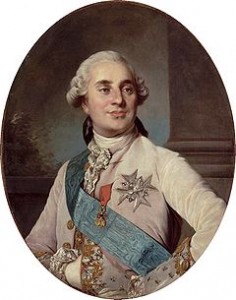 On this day in 1793, King of France and Navarre from 1774 until 1791, then King of the French from 1791 to 1792, Louis XVI, was executed by guillotine at the age of 37 at the Place de la Révolution, now known as the Place de la Concorde in Paris. Born Louis Auguste de France, Duc de Berry on 23 August 1754 in the Palace of Versailles. Louis-Auguste was the third son of Louis, the Dauphin of France, and thus the grandson of Louis XV of France. His brothers and father predeceased Louis XV, thus Louis-Auguste became the new Dauphin. On 16 May 1770, at the age of fifteen, Louis-Auguste married the fourteen-year-old Habsburg Archduchess Maria Antonia (better known by the French form of her name, Marie Antoinette), his second cousin once removed and the youngest daughter of the Holy Roman Emperor Francis I and his wife, the formidable Empress Maria Theresa. Louis XV died on 10 May 1774 and Louis-Auguste Dauphin was crowned king on 11 June 1775 at the age of 20. Suspended and arrested as part of the insurrection of the 10th of August in 1792 during the French Revolution, he was tried by the National Convention and found guilty of high treason, the only king of France ever to be executed. Although Louis XVI was beloved at first, his indecisiveness and conservatism led some elements of the people of France to eventually view him as a symbol of the perceived tyranny of the Ancien Régime and gave him the nickname Oncle Louis (“Uncle Louis”). Louis was also nicknamed Louis le Dernier (Louis the Last), a derisive use of the traditional nicknaming of French kings.
On this day in 1793, King of France and Navarre from 1774 until 1791, then King of the French from 1791 to 1792, Louis XVI, was executed by guillotine at the age of 37 at the Place de la Révolution, now known as the Place de la Concorde in Paris. Born Louis Auguste de France, Duc de Berry on 23 August 1754 in the Palace of Versailles. Louis-Auguste was the third son of Louis, the Dauphin of France, and thus the grandson of Louis XV of France. His brothers and father predeceased Louis XV, thus Louis-Auguste became the new Dauphin. On 16 May 1770, at the age of fifteen, Louis-Auguste married the fourteen-year-old Habsburg Archduchess Maria Antonia (better known by the French form of her name, Marie Antoinette), his second cousin once removed and the youngest daughter of the Holy Roman Emperor Francis I and his wife, the formidable Empress Maria Theresa. Louis XV died on 10 May 1774 and Louis-Auguste Dauphin was crowned king on 11 June 1775 at the age of 20. Suspended and arrested as part of the insurrection of the 10th of August in 1792 during the French Revolution, he was tried by the National Convention and found guilty of high treason, the only king of France ever to be executed. Although Louis XVI was beloved at first, his indecisiveness and conservatism led some elements of the people of France to eventually view him as a symbol of the perceived tyranny of the Ancien Régime and gave him the nickname Oncle Louis (“Uncle Louis”). Louis was also nicknamed Louis le Dernier (Louis the Last), a derisive use of the traditional nicknaming of French kings.
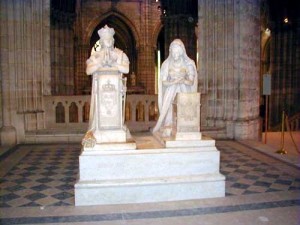
Funerary statue of Louis XVI and Marie Antoinette
The Final Footprint – Upon arrival at the Place de la Révolution, Louis stepped out of the carriage and removed his outer garments, refusing any offers of help, and folded them neatly. The gendarmes made a move to bind his hands, but Louis recoiled, and a struggle seemed imminent, until Father Edgeworth reminded him that Jesus had suffered his hands to be bound on Good Friday. Louis said, “So be it, then, that too, my God,” and offered his hands to be bound. He ascended the steps to the scaffold alone, with strength and determination. Upon reaching the top, he addressed the people:
“I die innocent of all the crimes laid to my charge; I pardon those who have occasioned my death; and I pray to God that the blood you are going to shed may never be visited on France.”
He would have said more, but a man on horseback called for the drums, and the crowd called for the execution, which was hastily carried out. A young guard picked up the severed head and promenaded it around the scaffold. The silence was broken with a cry of “Vive la République!” and thousands began cheering the death of the king. Louis XVI’s body was interred in an unmarked grave in the churchyard of L’église de la Madeleine. When Marie was guillotined on 16 October 1793, she was interred there as well. The Chapelle expiatoire was partly constructed on the grounds of the former Madeleine Cemetery. There is an inscription above the entrance, which reads (translated): “King Louis XVIII raised this monumnet to consecrate the place where the mortal remains of King Louis XVI and Marie-Antoinette, transferred on 21 January 1815 in the royal tomb of Saint-Denis, reposed for 21 years. It was finished during the second year of the reign of Charles X , year of grace 1826.” During Napoleon’s exile in Elba, the restored Bourbons ordered a search for the corpses of Louis XVI and Marie. The few remains, a few bones that were presumably the king’s and a clump of greyish matter containing a lady’s garter, were found on 21 January 1815, brought to the Cathedral Basilica of Saint-Denis and entombed in the crypt.
#RIP #OTD in 1932 writer (Eminent Victorians), critic, a founding member of the Bloomsbury Group, Lytton Strachey died of stomach cancer in Ham, Wiltshire, England, aged 51. St. Andrew’s Churchyard, Chew Magna, Somerset, England. His reported final words were: “If this is dying, then I don’t think much of it.”
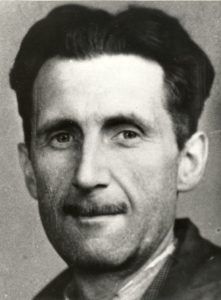 On this day in 1950, novelist, essayist, journalist and critic George Orwell died from a pulmonary aneurysm in University College Hospital in London, at the age of 46. Born Eric Arthur Blair on 25 June 1903 in Motihari, Bihar, British India (present-day East Champaran, Bihar, India). His work is marked by lucid prose, awareness of social injustice, opposition to totalitarianism, and outspoken support of democratic socialism.
On this day in 1950, novelist, essayist, journalist and critic George Orwell died from a pulmonary aneurysm in University College Hospital in London, at the age of 46. Born Eric Arthur Blair on 25 June 1903 in Motihari, Bihar, British India (present-day East Champaran, Bihar, India). His work is marked by lucid prose, awareness of social injustice, opposition to totalitarianism, and outspoken support of democratic socialism.
Orwell wrote literary criticism, poetry, fiction and polemical journalism. He is best known for the allegorical novella Animal Farm (1945) and the dystopian novel Nineteen Eighty-Four (1949). His non-fiction works, including The Road to Wigan Pier (1937), documenting his experience of working class life in the north of England, and Homage to Catalonia (1938), an account of his experiences on the Republican side in the Spanish Civil War, are widely acclaimed, as are his essays on politics, literature, language and culture.
Orwell’s work continues to influence popular and political culture and the term “Orwellian”—descriptive of totalitarian or authoritarian social practices—has entered the language together with many of his neologisms, including “Big Brother”, “Thought Police”, “Room 101”, “memory hole”, “newspeak”, “doublethink”, “proles”, “unperson” and “thoughtcrime”.
Orwell married Eileen O’Shaugnessy on 9 June 1936, at St Mary’s Church, Wallington, Hertfordshire. Eileen died on 29 March 1945 in Newcastle upon Tyne.
In mid-1949, he courted Sonia Brownell, and they announced their engagement in September, shortly before he was removed to University College Hospital in London. Orwell’s wedding took place in the hospital room on 13 October 1949.
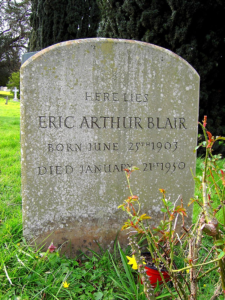 The Final Footprint
The Final Footprint
Orwell had requested to be buried in accordance with the Anglican rite in the graveyard of the closest church to wherever he happened to die. The graveyards in central London had no space, and fearing that he might have to be cremated against his wishes, his widow appealed to his friends to see whether any of them knew of a church with space in its graveyard. His friend David Astor lived in Sutton Courtenay, Oxfordshire, and arranged for Orwell to be interred in the churchyard of All Saints’ there. Orwell’s gravestone bears the simple epitaph: “Here lies Eric Arthur Blair, born June 25th 1903, died January 21st 1950”; no mention is made on the gravestone of his more famous pen name.
#RIP #OTD in 1959 film director (The Ten Commandments, Cleopatra, Samson and Delilah, The Greatest Show on Earth), producer and actor Cecil B. DeMille died from a heart attack in Hollywood, aged 77. Hollywood Forever Cemetery
#RIP #OTD in 1959 singer, child actor (Alfalfa in Our Gang), dog breeder, and guide, Carl Switzer was fatally shot by an acquaintance in a dispute over money; Mission Hills, California aged 31. Hollywood Forever
#RIP #OTD in 1967 actress (San Quentin, Angels with Dirty Faces, They Drive by Night, The Man Who Came to Dinner, Kings Row, Nora Prentiss, I Was a Male War Bride) Ann Sheridan died from esophageal cancer in Los Angeles, aged 51. Chapel Columbarium, Hollywood Forever Cemetery
#RIP #OTD in 1984 singer (“That’s Why (I Love You So)”, “I’ll Be Satisfied”, “Lonely Teardrops”) Mr. Excitement, Jackie Wilson died from pneumonia complications in Mount Holly, New Jersey, aged 49. Westlawn Cemetery, Wayne, Michigan
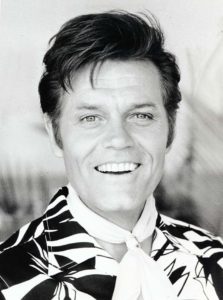 On this day in 1998, actor, director and producer Jack Lord died of congestive heart failure at his home in Honolulu, at age 77. Born John Joseph Patrick Ryan on December 30, 1920 in Brooklyn. Perhaps best known for his starring role as Steve McGarrett in the CBS television program Hawaii Five-O, which ran from 1968 to 1980. Lord was the first actor to play the character Felix Leiter in the James Bond film series, introduced in the first Bond film, Dr. No.
On this day in 1998, actor, director and producer Jack Lord died of congestive heart failure at his home in Honolulu, at age 77. Born John Joseph Patrick Ryan on December 30, 1920 in Brooklyn. Perhaps best known for his starring role as Steve McGarrett in the CBS television program Hawaii Five-O, which ran from 1968 to 1980. Lord was the first actor to play the character Felix Leiter in the James Bond film series, introduced in the first Bond film, Dr. No.
Lord’s first marriage to Anne Willard ended in divorce in 1947. He met his second wife while house hunting in upstate New York. On January 17, 1949, Lord married Marie de Narde, who gave up her career in fashion design to devote her life to him. Marie designed Lord’s off-camera wardrobe, as well as her own.
Lord was known for being a cultured man who loved reading poetry out loud on the set of his television show and for being reclusive at his Honolulu home.
The Final Footprint
Cremains scattered in the Pacific near his home.
#RIP #OTD in 1999 stage and screen actress (The Diary of Anne Frank; In Praise of Older Women;, Manitou), memoirist, Susan Strasberg died of breast cancer at her home in New York City aged 60. Cremation
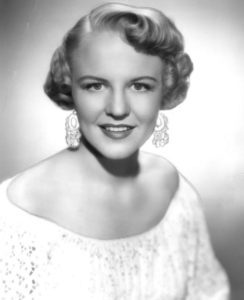 On this day in 2002, jazz and popular music singer, songwriter, composer, and actress Peggy Lee died of complications from diabetes and a heart attack in Bel Air, Los Angeles, at the age of 81. Born Norma Deloris Egstrom on May 26, 1920 in Jamestown, North Dakota. Her career spanned six decades. From her beginning as a vocalist on local radio to singing with Benny Goodman‘s big band, she forged a sophisticated persona, evolving into a multi-faceted artist and performer. During her career, she wrote music for films, acted, and recorded conceptual record albums that combined poetry and music. Lee was nominated for twelve Grammy Awards, winning Best Contemporary Vocal Performance for her 1969 hit “Is That All There Is?” In 1995 she was given the Grammy Lifetime Achievement Award.
On this day in 2002, jazz and popular music singer, songwriter, composer, and actress Peggy Lee died of complications from diabetes and a heart attack in Bel Air, Los Angeles, at the age of 81. Born Norma Deloris Egstrom on May 26, 1920 in Jamestown, North Dakota. Her career spanned six decades. From her beginning as a vocalist on local radio to singing with Benny Goodman‘s big band, she forged a sophisticated persona, evolving into a multi-faceted artist and performer. During her career, she wrote music for films, acted, and recorded conceptual record albums that combined poetry and music. Lee was nominated for twelve Grammy Awards, winning Best Contemporary Vocal Performance for her 1969 hit “Is That All There Is?” In 1995 she was given the Grammy Lifetime Achievement Award.
Lee was married four times: to guitarist and composer Dave Barbour (1943–1951), actor Brad Dexter (1953), actor Dewey Martin (1956–1958), and percussionist Jack Del Rio (1964–1965). All the marriages ended in divorce.

The Final Footprint
She was cremated and her ashes were inurned in a bench-style monument in Westwood Village Memorial Park Cemetery in Los Angeles. Other notable final footprints at Westwood include; Ray Bradbury, Sammy Cahn, James Coburn, Rodney Dangerfield, Kirk Douglas, Janet Leigh, Farrah Fawcett, Hugh Hefner, Brian Keith, Don Knotts, Burt Lancaster, Peter Lawford, Jack Lemmon, Karl Malden, Dean Martin, Walter Mathau, Marilyn Monroe, Carroll O’Connor, Roy Orbison, George C. Scott, Dorothy Stratten, Natalie Wood and Frank Zappa.
Have you planned yours yet?
Follow TFF on twitter @RIPTFF

